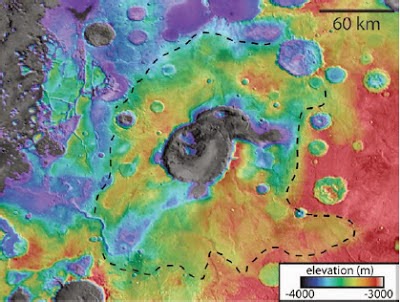Landslides on Mars typically have much greater runout distances than
those on Earth, due to the planets lower gravity and thinner atmosphere. This
can lead to areas of layered deposits from different landslides quite distant
from the source, particularly within the larger canyons on Mars. Since it is
possible to produce approximate ages for such deposits based upon the number of
impact craters on the surface of the deposit (meteors are thought to fall onto
planets at a steady rate, therefore there should be a direct relationship
between the number of impact craters on a surface and its range), it is
therefore possible to try to understand the long-term evolution of these
deposits once in situ, and therefore potentially the nature of the material in
such deposits.
In a paper published in the journal Geology on 29 July 2014, PeterGrindrod of the Department of Earth and Planetary Sciences and Centre forPlanetary Sciences at Birkbeck College, University of London and Nicholas Warner of
the Jet Propulsion Laboratory at the California Institute of Technology and the
Department of Geological Sciences at the State University of New York at Geneseo, attempt to understand the sequence of events that led to the formation
of a layered landslide deposit in the Ophir Chasma area of the Mariner Valley
visible in images from the Mars Reconnaissance Orbiter.
By counting craters over 100 m in diameter on the various deposits
in the area, Gridrod and Warner conclude that the oldest deposits in the
sequence were around 423 million years old and the youngest are about 216
million years old. However the relationship between craters of 30-50 m in
diameter was not consistent with predictions, suggesting that craters are being
eroded over time.
Landslide ages from crater count studies. Mars
Reconnaissance Orbiter Context Camera base map showing location of the six
landslides dated using crater counting. Numbers represent relative
stratigraphic position of the landslide as inferred from superposition relationships.
ILDs—interior layered deposits. Inset shows relative stratigraphic age determined
from landslide boundaries in direct contact. Grindrod & Warner (2014).
Based upon the apparent rate of erosion of craters, and the apparent
diversion of later landslides by layered deposits that have subsequently been
eroded, Grindrod and Warner conclude that the deposits are being eroded at a
very high rate for Mars, with about 500 m of material having been removed since
the deposits were laid down.
Grindrod and Warner suggest two possible ways in which this could
occur. Firstly aeolian abrasion, in which deposits are abraded away by friction
with wind-blown particles (saltation), which could potentially erode away 500 m
of sediment in the Mariner Valley in 18 to 101 million years. Secondly ice
sublimation, in which ice particles (carbon dioxide rather than water) in the
deposits are sublimated away (turn directly from solids to gasses) as they
warm. This could potentially lead to the loss of 500 m of deposits in as little
as 57 million years. However the OphirChasma deposits are quite close to the Martian
Equator, where ice deposits are not currently predicted; if substantial amounts
of ice were present in deposits laid down between 200 and 400
million years ago, then significantly cooler temperatures must have
existed in the region at these times than can be accounted for by our
understanding of Martian climate cycles.
See also…
 Ice in Martian impact craters. The surface of Mars has been observed continuously by the Mars Orbiter Camera from 1997 to 2006 and the Mars Reconnaissance Orbiter since 2006. During the time that these observations have been occurring
around 200 new impact craters have been observed...
Ice in Martian impact craters. The surface of Mars has been observed continuously by the Mars Orbiter Camera from 1997 to 2006 and the Mars Reconnaissance Orbiter since 2006. During the time that these observations have been occurring
around 200 new impact craters have been observed...
The potential of there being life on Mars has been a stalwart of popular
fiction for over a century, though to date no signs of actual life have
been discovered. Recent discoveries of geological structures on Mars
that indicate the presence of large bodies of open water in the early
history of the planet. This new understanding of the planet makes the
search for evidence of ancient life on Mars a more realistic prospect...
Much of the surface of Mars is covered by volcanic rocks, and
sedimentary rocks which appear to be derived directly from volcanic
sources. However the planet lacks a clear source for this material, with
the...
Follow Sciency Thoughts on Facebook.


